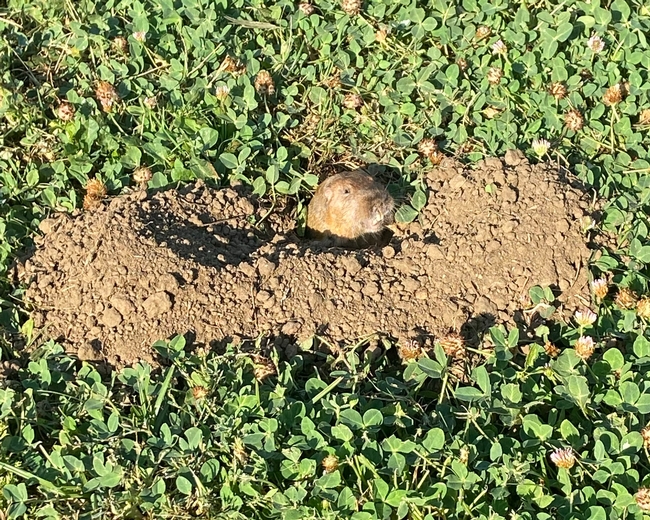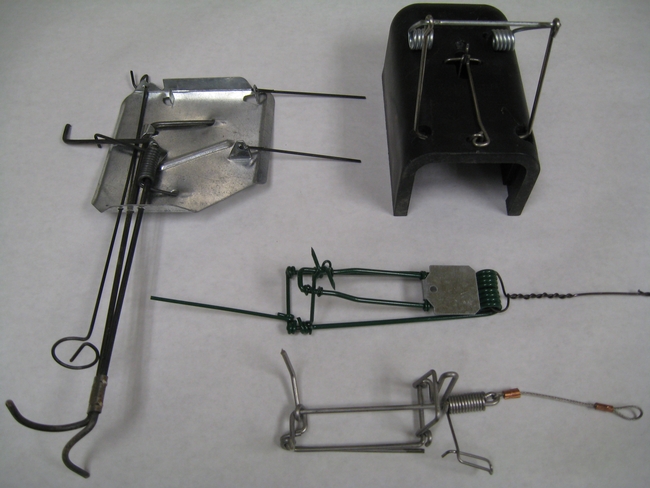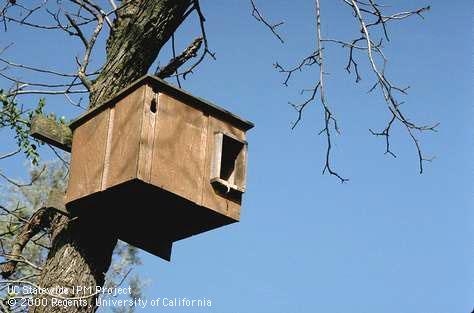Pocket gophers can cause significant damage to valuable turf, girdle trees, and chew irrigation lines. Their mounds can create tripping hazards and lead to erosion concerns when found on slopes. Luckily there are multiple successful management options to choose from when it comes to managing pocket gophers.
Do I have a pocket gopher?
Pocket gophers are small burrowing rodents that are often identified from the damage they cause rather than a sighting of the animal itself. Pocket gophers spend most of their time below the surface and while it is possible to see them above the ground, or peeping out of a burrow (Figure 1), the easiest way to determine the presence of pocket gophers is by the crescent-shaped mounds they leave behind on the surface from excavating their burrows. Pocket gopher mounds can be differentiated from mole mounds by their shape—mole mounds will be round whereas pocket gopher mounds have the distinctive crescent shape. Pocket gophers do not hibernate and are active year-round, so it is important to be vigilant when managing pocket gophers.
Management options
There are many management options for pocket gopher control and in California, significant research has been conducted to better utilize and examine the effectiveness of many of these tools. While there continues to be restrictions on some of the toxic options for pocket gopher management, there are still multiple non-chemical options to choose from that fit well into an IPM plan. Pocket gopher trapping has proven to be one of these very effective methods.
Trapping
Trapping is an excellent option for managing pocket gophers, even if you think you have a large population. In general, there is only one pocket gopher per tunnel system, so once you have captured one, you can move to the next system. Be aware that during the breeding season, there could be both a male and female in the burrow system, and after the female gives birth and the pups are dispersing, you can find the pups in the burrow system with reproducing females. In these scenarios, you might capture more than one pocket gopher per trap set.
Trapping takes longer when compared to toxic bait application or burrow fumigation with aluminum phosphide but it can be highly effective when done correctly.
Make sure you have the right tools when it comes to trapping pocket gophers. It is important to have sufficient traps for the population you are dealing with. Focus trapping efforts on fresh mounds, as older mounds are less likely to be active. If you are unsure what mounds are active, you can knock over all mounds and trap at the new mounds that appear. Pocket gophers may not mound every day, so trap over more than one day to be successful. It is worth noting that it can be difficult to determine individual burrow systems from each other. Some practice is required to better define which mounds are likely from the same individual. If a trap set is not successful after 1 or 2 days, move it to a new tunnel location.
Trap selection (Figure 2) and placement may be important when choosing trapping as your pocket gopher control method. In studies, the Gophinator trap caught larger pocket gophers at a higher rate than the Macacbee trap. In addition, these traps often require larger excavations in the soil. For areas like high value turf, these traps may not the best option. An alternative trap is one resembling the GopherHawk, which may cause less damage because they don't require as large of an excavation in the soil.
When you set a pincher-style trap like the Macabee or the Gophinator, or a box-type trap like the Black Box or Black Hole, it is important to locate the main run of the burrow system. To do this, take a long metal rod like a screwdriver and probe around the mound. You will need to stick your probe into the ground at depths of about 4 to 12 inches. When you find the tunnel, you will experience a sudden drop in resistance. This skill is difficult to acquire but will improve with practice. Once you have located the main run, you need to excavate an opening in the tunnel to allow for setting of the trap. You can use a hori-hori knife or a trowel to make this hole, which may need to be more or less extensive depending on which style trap you choose.
If you are using a pincher-style trap that is set inside the tunnel, make sure that the tunnel you are setting the trap in is straight. You can check this by putting your excavator tool into the tunnel and making sure that at least 6 inches of it fits into the tunnel. This way you know the tunnel doesn't turn; tunnels with turns often allow the pocket gopher to bypass the jaws when activating the trap, thereby resulting in triggered traps that miss the gopher.
Several attractants have been tested but they did not influence visitation or capture rates of pocket gophers to traps. Attractants also did not influence the gender of pocket gophers captured. There is no impact of human scent on the success of trapping pocket gophers.
Is blocking light by covering trap sets necessary when trapping for pocket gophers? Covering and uncovering pocket gopher trap sets is time consuming and does not result in a greater number of captures. However, if you are trapping in areas with high foot traffic, there may be some benefits to covering your trap sets. You can cover the traps with sod, landscape cloth, or something like cardboard or plywood to prevent people or pets from interfering with your trap sets. In general, it is recommended that you cover sets when using box traps, since pocket gophers will likely plug tunnels before hitting the trigger wire of these traps if you leave them uncovered.
It can be helpful to tie a flag to the traps so you can easily remember where they were set. This can also help you recover the trap if the gopher drags it away.
When you recover a dead pocket gopher, remove it from the trap, put the gopher back in the tunnel, and cover it up. You can also double bag the animal and place it in the trash. Always wear gloves when handling pocket gopher or any other wildlife carcasses.
Toxic baits
There are several options for pocket gopher management using toxic baits. It is important to ensure that bait is placed correctly in the tunnel either by using a probe with a bait applicator or by hand using a funnel and spoon. Always read and follow the label. Many toxic baits that are used to manage pocket gophers require a restricted materials permit. However, there may be exemptions for products applied for structural pest control, industrial use, and institutional use.
Strychnine is the most effective type of bait used for pocket gopher management. This toxicant is an acute rodenticide where a lethal dose can be acquired after a single feed. Pocket gophers can develop behavioral resistance to strychnine. This enables pocket gophers to consume what is normally more than the lethal amount by periodically eating sublethal amounts. Pocket gophers also can be physiologically tolerant to strychnine since after they ingest a series of higher doses of strychnine, they can tolerate increasingly higher doses of it. It is important to rotate strychnine in with other management tools to avoid this type of resistance.
Zinc phosphide is also an acute rodenticide that is lethal after a single feeding. Bait shyness or taste aversion can be associated with this management option. Because of this, zinc phosphide may not perform as well as strychnine.
First generation anticoagulant rodenticides, including chlorophacinone and diphacinone, are multiple-feeding anticoagulants that are less toxic than strychnine and zinc phosphide. Since these baits require multiple feedings over 3-5 days, it is important to make sure that there is a continuous supply of bait during your treatment period.
Fumigation
Aluminum phosphide is highly effective, especially in moist soils. However, aluminum phosphide is a highly restricted material. It must be applied by a certified applicator, or the application must be supervised by a qualified applicator. You must have a restricted materials permit, a written recommendation to apply on production or non-production agricultural sites, and a Notice of Intent (NOI) from your local Agricultural Commissioner. You are also required to have a Fumigation Management Plan. You are not permitted to apply this product within 100 feet of a potentially occupied structure. The only place on school grounds where it is permitted to apply this product is on athletic fields.
Gas cartridges are not effective because pocket gophers seal off their burrow when they detect the smoke.
Carbon monoxide producing machines and carbon dioxide are registered for use in California against burrowing rodents. Carbon monoxide producing machines are registered devices, while carbon dioxide used for rodent control is considered a registered pesticide.
Carbon monoxide devices generate carbon monoxide which fills the burrow system and asphyxiates the pocket gopher. These devices include the BurrowRx, Cheetah Rodent Controller, CO Jack, and Pressurized Exhaust Rodent Controller (PERC) Machine. Research has shown that the PERC machine can be moderately effective at managing pocket gopher populations. Its efficacy increases in moist soil conditions. Some of these devices are more suited for urban applications and some for larger scale production agriculture. You are not permitted to use a carbon monoxide pest control device within 100 feet of a structure inhabited by people or domestic animals, whether occupied or not.
Carbon dioxide gas is a pesticide that is registered for use on several sites that include production agriculture, non-production agricultural sites, and residential areas. There are no distance restrictions for the application of this pesticide. It is important to follow the label. Solid carbon dioxide (dry ice) is not registered for use on pocket gophers.
Natural predators
Vertebrate predators—including owls, snakes, cats, dogs, and coyotes—eat pocket gophers. However, they will rarely control all pocket gophers in an area. Predators rarely remove every prey animal but instead move on to hunt in areas with more prey. In addition, pocket gophers have defenses against predators. For example, pocket gophers can evade snakes in their burrows by pushing up an earthen plug to block the snake's advance. Relying solely on natural predators might not control pocket gophers to the desired level. Research has shown that pocket gophers appear to be an important prey animal for barn owls nesting in perennial crops, and thus barn owls may be able to provide some pest control services in those areas.
Exclusion
Exclusion can be difficult and expensive for pocket gopher management, but it may be justified if you are trying to protect individual or high-value landscape plants. You can use hardware cloth (1/2-3/4-inch mesh) buried at least 2 foot deep with an additional 6 inches of hardware cloth bent at a 90° angle. You should also extend fences at least 1 foot above the ground because pocket gophers may move above ground to access the planting you are trying to protect. There are wire baskets available to protect individual plants or bulbs from pocket gophers. These baskets can also be fashioned from chicken wire. Remember that it is important not to restrict the growth of the plant inside the basket, so ensure the wire basket is large enough to accommodate the adult plant's root structure.
For more information about pocket gopher management, see the UC IPM Pest Notes: Pocket Gophers.
[Originally featured in the Spring 2024 edition of the Green Bulletin Newsletter for structural and landscape pest professionals.]


